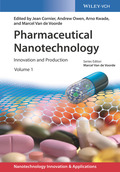Pharmaceutical Nanotechnology
Innovation and Production
Nanotechnology Innovation & Applications

1. Edition January 2017
775 Pages, Hardcover
162 Pictures (46 Colored Figures)
Monograph
Short Description
With its focus on concrete methods and recent advances in applying this technology to develop new drug therapies and medical diagnostics, this book provides an overall picture of the field, from the fundamentals of nanopharmacy to the role of nanoparticles and substances.
Buy now
Price: 332,00 €
Price incl. VAT, excl. Shipping
Euro prices for Wiley-VCH and Ernst & Sohn titles are only valid for Germany. In EU countries, local VAT applies. Postage will be charged.
With its focus on concrete methods and recent advances in applying nanotechnology to develop new drug therapies and medical diagnostics, this book provides an overall picture of the field, from the fundamentals of nanopharmacy with the characterisation and manufacturing methods to the role of nanoparticles and substances. Actual examples of utilization include drug development issues, translation to the clinic, market prospects, and industrial commercialization aspects. The applications described are taken from cancer treatment as well as other major therapeutic areas, such as infectious diseases and dermatology. An in-depth discussion on safety, regulatory, and societal aspects rounds off the book.
Written by a top team of editors and authors composed of the leading experts in Europe and the USA who have pioneered the field of nanopharmacy!
Industrial Requirements on Nanopharmacy Research
Introduction
Volume 1
PART I. ENTRY TO THE NANOPHARMACY REVOLUTION
History: Potential, Challenges, and Future Development in Nanopharmaceutical Research and Industry
Nanoscale Drugs: A Key to Revolutionary Progress in Pharmacy and Healthcare
The Emergence of Nanopharmacy: From Biology to Nanotechnology and Drug Molecules to Nanodrugs
Understanding and Characterizing Functional Properties of Nanoparticles
Omics-Based Nanopharmacy: Powerful Tools Towards Precision Medicine
PART II. FUNDAMENTALS OF NANOTECHNOLOGY IN PHARMACY
Nanostructure in Drug Delivery
Characterization Methods: Physical and Chemical Characterization Techniques
Nanoparticle Characterization Methods: Applications of Synchrotron and Neutral Radiation
Overview of Techniques and Description of Established Processes
Nanopharmacy: Exploratory Methods for Polymeric Materials
Overview and Presentation of Exploratory Methods for Manufacturing Nanoparticles / "Inorganic Materials"
Scale-Up and cGMP Manufacturing of Nanodrug Delivery Systems for Clinical Investigations
Occupational Safety and Health
Volume 2
PART III. DEVELOPMENT OF NANOPHARMACEUTICALS
Micro- and Nano-Tools in Drug Discovery
Computational Predictive Models for Nanomedicine
Drug Targeting in Nanomedicine and Nanopharmacy: A Systems Approach
Nanoparticle Toxicity: General Overview and Insights Into Immunological Compatibility
An Overview of Nanoparticle Biocompatibility for Their Use in Nanomedicine
Translation to the Clinic: Preclinical and Clinical Pharmacology Studies of Nanoparticles - The Translational Challenge
Regulatory Issues in Nanomedicines
Social Studies of Nanopharmaceutical Research
PART IV. PHARMACEUTICAL APPLICATIONS OF NANOMATERIALS
Nanoparticles for Imaging and Imaging Nanoparticles: State of the Art and Current Prospects
Nanoparticle-Based Physical Methods for Medical Treatments
Nanodrugs in Medicine and Healthcare: Oral Delivery
Steroidal Nanodrugs Based on Pegylated Nanoliposomes Remote Loaded with Amphipathic Weak Acids Steroid Prodrugs as Anti-Inflammatory Agents
Nanodrugs in Medicine and Healthcare: Pulmonary, Nasal and Ophthalmic Routes, and Vaccination
Neurodegenerative Diseases - Alzheimer's Disease
PART V. THE NANOPHARMACEUTICAL MARKET
A Practical Guide to Translating Nanomedical Products
Development and Commercialization of Nanocarrier-Based Drug Products
Future Outlook of Nanopharmacy: Challenges and Opportunities
Index
Professor Arno Kwade is Head of the Center of Pharmaceutical Engineering and of the Institute of Particle Technology at the Technical University Braunschweig, Germany. After his PhD he worked nine years in industry as partner of a consulting firm for processing and handling of materials and as general manager of a medium-sized company active in materials processing. Professor Kwade is speaker of the European working party on comminution and classification and developed a course on nanomilling, taken by more than 1000 participants from different industries, among them many pharmaceutical companies.
Professor Andrew Owen holds a personal Chair in Molecular and Clinical Pharmacology at the University of Liverpool, UK. He is also affiliated to the MRC Centre for Drug Safety Science and the Wolfson Centre for Personalised Medicine. He is Chair of the British Society for Nanomedicine, is co-inventor of several patents related to nanomedicines and has contributed to over 150 publications and book chapters. He is co-founder of University commercial start-ups, a Fellow of the Royal Society of Biology, a Fellow of the British Pharmacological Society and member of the steering committee for the Academy of Pharmaceutical Sciences Nanomedicine Focus Group.
Marcel Van de Voorde has 40 years` experience in European Research Organisations including CERN-Geneva, European Commission, with 10 years at the Max Planck Institute in Stuttgart, Germany. For many years, he was involved in research and research strategies, policy and management, especially in European research institutions. He holds a Professorship at the University of Technology in Delft, the Netherlands, as well as multiple visiting professorships in Europe and worldwide. He holds a doctor honoris causa and various honorary Professorships.
He is senator of the European Academy for Sciences and Arts, in Salzburg and Fellow of the World Academy for Sciences. He is a Fellow of various scientific societies and has been decorated by the Belgian King. He has authored of multiple scientific and technical publications and co-edited multiple books in the field of nanoscience and nanotechnology.


